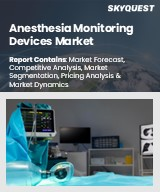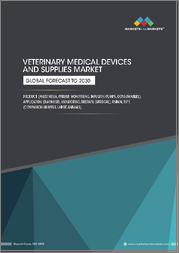
|
시장보고서
상품코드
1663880
마취 기기 시장 규모, 점유율, 성장 분석 : 제품 유형별, 용도별, 최종사용자별, 지역별 - 산업 예측(2025-2032년)Anesthesia Devices Market Size, Share, and Growth Analysis, By Product Type (Anesthesia Machines, Anesthesia Disposables), By Application (General Anesthesia, Regional Anesthesia), By End-User, By Region - Industry Forecast 2025-2032 |
||||||
마취 기기 시장 규모는 2023년에 187억 5,000만 달러에 달하며, 예측 기간(2025-2032년)의 CAGR은 7.8%로, 2024년 202억 1,000만 달러에서 2032년에는 368억 6,000만 달러로 성장할 전망입니다.
마취 기기의 세계 시장은 수술 건수 증가와 의료 시설에서 마취가 필요한 만성질환의 높은 유병률로 인해 큰 성장이 예상됩니다. 혁신적인 마취 솔루션 개발을 위한 투자 증가와 함께 마취 기술의 발전은 새로운 개발 기회를 창출할 것입니다. 또한 노인 인구 증가와 의료 인프라의 급격한 증가는 이 분야의 기업에게 시장 전망을 높여줄 것으로 예상됩니다. 그러나 첨단 장비의 높은 비용, 숙련된 전문가 부족, 엄격한 규제 장벽, 신흥 국가 시장에서의 낮은 인지도 등은 당분간 마취 기기 제조업체에 제약이 될 수 있습니다. 전반적으로 업계 상황은 유망한 성장 경로와 업계 참가자들에게 주목할 만한 과제를 모두 제시하고 있습니다.
목차
서론
- 조사의 목적
- 조사 범위
- 정의
조사 방법
- 정보 조달
- 2차와 1차 데이터 방법
- 시장 규모 예측
- 시장의 전제조건과 제한
개요
- 세계 시장 전망
- 공급과 수요 동향 분석
- 부문별 기회 분석
시장 역학과 전망
- 시장 개요
- 시장 규모
- 시장 역학
- 촉진요인과 기회
- 억제요인과 과제
- Porter의 산업 분석
주요 시장 인사이트
- 주요 성공 요인
- 경쟁의 정도
- 주요 투자 기회
- 시장 에코시스템
- 시장의 매력 지수(2024년)
- PESTEL 분석
- 거시경제 지표
- 밸류체인 분석
- 가격 분석
- 사례 연구
- 규제 상황
- 특허 분석
- 기술 분석
마취 기기 시장 규모 : 제품 유형별 & CAGR(2025-2032)
- 시장 개요
- 마취기
- 마취용 일회용 기구
- 마취용 액세서리
마취 기기 시장 규모 : 용도별 & CAGR(2025-2032)
- 시장 개요
- 전신 마취
- 부분 마취
- 국소 마취
마취 기기 시장 규모 : 최종사용자별 & CAGR(2025-2032)
- 시장 개요
- 병원
- 외래 수술 센터
- 클리닉
마취 기기 시장 규모 : 지역별 & CAGR(2025-2032)
- 북미
- 미국
- 캐나다
- 유럽
- 독일
- 스페인
- 프랑스
- 영국
- 이탈리아
- 기타 유럽 지역
- 아시아태평양
- 중국
- 인도
- 일본
- 한국
- 기타 아시아태평양
- 라틴아메리카
- 브라질
- 기타 라틴아메리카 지역
- 중동 및 아프리카
- GCC 국가
- 남아프리카공화국
- 기타 중동 및 아프리카
경쟁 정보
- 상위 5사의 비교
- 주요 기업의 시장 포지셔닝(2024년)
- 주요 시장 기업이 채택한 전략
- 최근 시장 동향
- 기업의 시장 점유율 분석(2024년)
- 주요 기업의 기업 개요
- 기업의 상세
- 제품 포트폴리오 분석
- 기업의 부문별 점유율 분석
- 매출의 전년대비 비교(2022-2024)
주요 기업 개요
- Medtronic PLC(USA)
- B. Braun Melsungen AG(Germany)
- Dragerwerk AG & Co. KGaA(Germany)
- General Electric Company(USA)
- Koninklijke Philips N.V.(Netherlands)
- Fisher & Paykel Healthcare Corporation Limited(New Zealand)
- Smiths Medical(USA)
- Teleflex Incorporated(USA)
- Ambu A/S(Denmark)
- Mindray Medical International Limited(China)
- Criticare Systems, Inc.(USA)
- HEYER Medical AG(Germany)
- Infinium Medical, Inc.(USA)
- General Meditech, Inc.(China)
- Schiller AG(Switzerland)
- Masimo Corporation(USA)
- BD(Becton, Dickinson and Company)(USA)
- 3M Company(USA)
- Olympus Corporation(Japan)
- Nihon Kohden Corporation(Japan)
결론과 제안
KSA 25.04.01Anesthesia Devices Market size was valued at USD 18.75 billion in 2023 and is poised to grow from USD 20.21 billion in 2024 to USD 36.86 billion by 2032, growing at a CAGR of 7.8% during the forecast period (2025-2032).
The global market for anesthesia devices is poised for significant growth, driven by increasing surgical volumes and a high prevalence of chronic diseases necessitating anesthesia in healthcare facilities. Emerging opportunities arise from advancements in anesthetic technologies, alongside rising investments aimed at developing innovative anesthesia solutions. Furthermore, the expanding geriatric population and burgeoning healthcare infrastructure are anticipated to enhance market prospects for companies in this sector. However, challenges such as the high costs of advanced devices, a shortage of skilled professionals, stringent regulatory hurdles, and limited awareness in developing markets may pose constraints for anesthesia device suppliers in the foreseeable future. Overall, the landscape presents both promising growth avenues and notable challenges for industry participants.
Top-down and bottom-up approaches were used to estimate and validate the size of the Anesthesia Devices market and to estimate the size of various other dependent submarkets. The research methodology used to estimate the market size includes the following details: The key players in the market were identified through secondary research, and their market shares in the respective regions were determined through primary and secondary research. This entire procedure includes the study of the annual and financial reports of the top market players and extensive interviews for key insights from industry leaders such as CEOs, VPs, directors, and marketing executives. All percentage shares split, and breakdowns were determined using secondary sources and verified through Primary sources. All possible parameters that affect the markets covered in this research study have been accounted for, viewed in extensive detail, verified through primary research, and analyzed to get the final quantitative and qualitative data.
Anesthesia Devices Market Segments Analysis
Global Anesthesia Devices Market is segmented by Product Type, Application, End-User and region. Based on Product Type, the market is segmented into Anesthesia Machines, Anesthesia Disposables and Anesthesia Accessories. Based on Application, the market is segmented into General Anesthesia, Regional Anesthesia and Local Anesthesia. Based on End-User, the market is segmented into Hospitals, Ambulatory Surgical Centers and Clinics. Based on region, the market is segmented into North America, Europe, Asia Pacific, Latin America and Middle East & Africa.
Driver of the Anesthesia Devices Market
The anesthesia devices market is significantly driven by the rising number of outpatient surgeries and minimally invasive procedures, attributed to the growing prevalence of chronic diseases globally. As more patients require effective anesthesia for these surgeries, the demand for advanced anesthesia devices across various healthcare facilities is expected to increase steadily over time. This trend indicates a vital need for reliable and efficient anesthesia solutions to ensure patient safety and comfort, ultimately supporting the expansion of the anesthesia devices market as healthcare providers adapt to the changing landscape of surgical interventions.
Restraints in the Anesthesia Devices Market
The anesthesia devices market faces a significant constraint due to the necessity for specialized knowledge in operating advanced anesthesia equipment. Currently, there is a notable shortage of skilled operators globally, which is particularly acute in rural and remote regions where healthcare infrastructure is underdeveloped. This lack of trained professionals severely hampers the sales and effective utilization of anesthesia devices in these areas. As a result, healthcare facilities in less developed locations struggle to provide adequate anesthesia services, limiting market growth and accessibility for patients in need of anesthesia-related procedures. Addressing this skill gap is crucial for the advancement of the market.
Market Trends of the Anesthesia Devices Market
As the healthcare landscape increasingly shifts towards home care and ambulatory settings, the demand for portable and wireless anesthesia devices is surging. This trend is driven by the need for flexibility, ease of use, and enhanced compatibility in diverse care environments. Manufacturers are expected to harness technological advancements to develop innovative solutions that prioritize mobility and user-friendliness, allowing healthcare professionals to administer anesthesia with greater efficiency outside traditional hospital settings. These portable and wireless devices are poised to become a cornerstone of the anesthesia devices market, addressing evolving patient needs while facilitating improved outcomes and streamlined workflows in various care scenarios.
Table of Contents
Introduction
- Objectives of the Study
- Scope of the Report
- Definitions
Research Methodology
- Information Procurement
- Secondary & Primary Data Methods
- Market Size Estimation
- Market Assumptions & Limitations
Executive Summary
- Global Market Outlook
- Supply & Demand Trend Analysis
- Segmental Opportunity Analysis
Market Dynamics & Outlook
- Market Overview
- Market Size
- Market Dynamics
- Drivers & Opportunities
- Restraints & Challenges
- Porters Analysis
- Competitive rivalry
- Threat of substitute
- Bargaining power of buyers
- Threat of new entrants
- Bargaining power of suppliers
Key Market Insights
- Key Success Factors
- Degree of Competition
- Top Investment Pockets
- Market Ecosystem
- Market Attractiveness Index, 2024
- PESTEL Analysis
- Macro-Economic Indicators
- Value Chain Analysis
- Pricing Analysis
- Case Studies
- Regulatory Landscape
- Patent Analysis
- Technology Analysis
Global Anesthesia Devices Market Size by Product Type & CAGR (2025-2032)
- Market Overview
- Anesthesia Machines
- Anesthesia Disposables
- Anesthesia Accessories
Global Anesthesia Devices Market Size by Application & CAGR (2025-2032)
- Market Overview
- General Anesthesia
- Regional Anesthesia
- Local Anesthesia
Global Anesthesia Devices Market Size by End-User & CAGR (2025-2032)
- Market Overview
- Hospitals
- Ambulatory Surgical Centers
- Clinics
Global Anesthesia Devices Market Size & CAGR (2025-2032)
- North America (Product Type, Application, End-User)
- US
- Canada
- Europe (Product Type, Application, End-User)
- Germany
- Spain
- France
- UK
- Italy
- Rest of Europe
- Asia Pacific (Product Type, Application, End-User)
- China
- India
- Japan
- South Korea
- Rest of Asia-Pacific
- Latin America (Product Type, Application, End-User)
- Brazil
- Rest of Latin America
- Middle East & Africa (Product Type, Application, End-User)
- GCC Countries
- South Africa
- Rest of Middle East & Africa
Competitive Intelligence
- Top 5 Player Comparison
- Market Positioning of Key Players, 2024
- Strategies Adopted by Key Market Players
- Recent Developments in the Market
- Company Market Share Analysis, 2024
- Company Profiles of All Key Players
- Company Details
- Product Portfolio Analysis
- Company's Segmental Share Analysis
- Revenue Y-O-Y Comparison (2022-2024)
Key Company Profiles
- Medtronic PLC (USA)
- Company Overview
- Business Segment Overview
- Financial Updates
- Key Developments
- B. Braun Melsungen AG (Germany)
- Company Overview
- Business Segment Overview
- Financial Updates
- Key Developments
- Dragerwerk AG & Co. KGaA (Germany)
- Company Overview
- Business Segment Overview
- Financial Updates
- Key Developments
- General Electric Company (USA)
- Company Overview
- Business Segment Overview
- Financial Updates
- Key Developments
- Koninklijke Philips N.V. (Netherlands)
- Company Overview
- Business Segment Overview
- Financial Updates
- Key Developments
- Fisher & Paykel Healthcare Corporation Limited (New Zealand)
- Company Overview
- Business Segment Overview
- Financial Updates
- Key Developments
- Smiths Medical (USA)
- Company Overview
- Business Segment Overview
- Financial Updates
- Key Developments
- Teleflex Incorporated (USA)
- Company Overview
- Business Segment Overview
- Financial Updates
- Key Developments
- Ambu A/S (Denmark)
- Company Overview
- Business Segment Overview
- Financial Updates
- Key Developments
- Mindray Medical International Limited (China)
- Company Overview
- Business Segment Overview
- Financial Updates
- Key Developments
- Criticare Systems, Inc. (USA)
- Company Overview
- Business Segment Overview
- Financial Updates
- Key Developments
- HEYER Medical AG (Germany)
- Company Overview
- Business Segment Overview
- Financial Updates
- Key Developments
- Infinium Medical, Inc. (USA)
- Company Overview
- Business Segment Overview
- Financial Updates
- Key Developments
- General Meditech, Inc. (China)
- Company Overview
- Business Segment Overview
- Financial Updates
- Key Developments
- Schiller AG (Switzerland)
- Company Overview
- Business Segment Overview
- Financial Updates
- Key Developments
- Masimo Corporation (USA)
- Company Overview
- Business Segment Overview
- Financial Updates
- Key Developments
- BD (Becton, Dickinson and Company) (USA)
- Company Overview
- Business Segment Overview
- Financial Updates
- Key Developments
- 3M Company (USA)
- Company Overview
- Business Segment Overview
- Financial Updates
- Key Developments
- Olympus Corporation (Japan)
- Company Overview
- Business Segment Overview
- Financial Updates
- Key Developments
- Nihon Kohden Corporation (Japan)
- Company Overview
- Business Segment Overview
- Financial Updates
- Key Developments



















